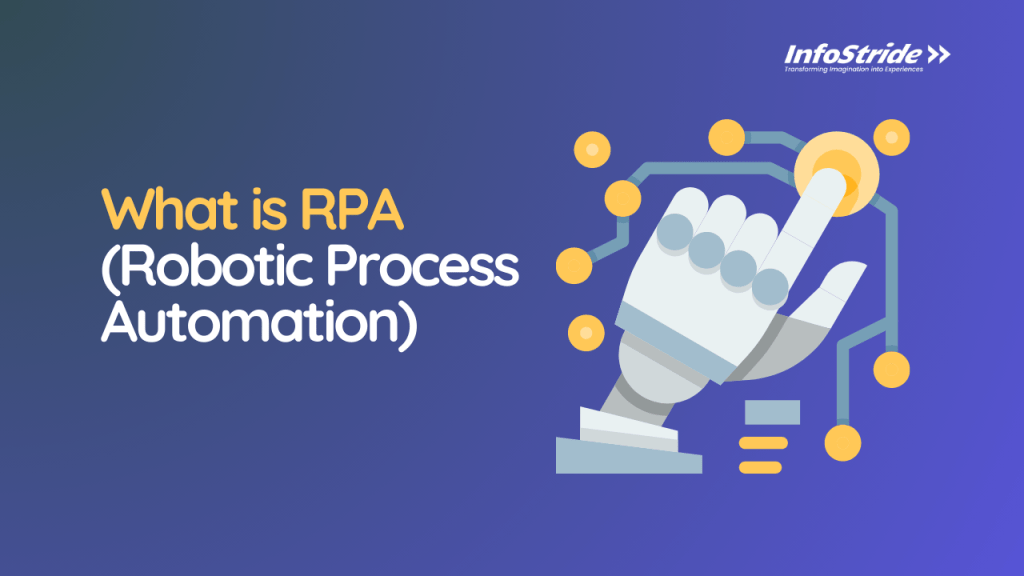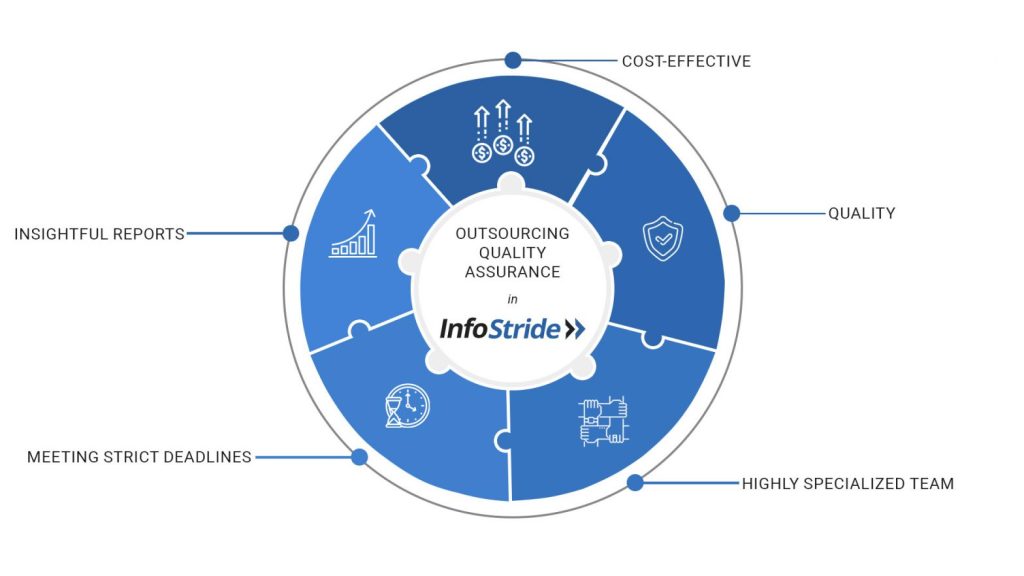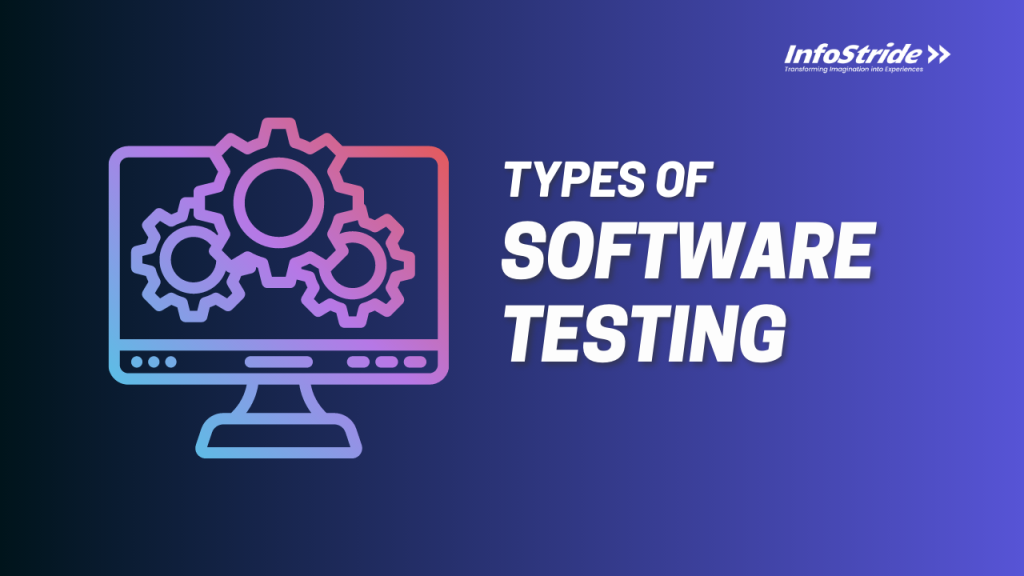Table of Content
Going for eCommerce Platform vs Custom eCommerce Development
Most Popular eCommerce Websites in 2024
Must-Have Features for eCommerce Websites in 2024:
Major Factors Affecting The eCommerce Website Development Cost in 2024
Tech-Stack Required To Build An eCommerce website
Key Factors to Consider When Choosing the Technology Stack:
eCommerce Website Development Cost Breakdown
Why Choose InfoStride For Your Next eCommerce Software Development Project
The eCommerce market is valued at $8.80 trillion globally in 2024 and is estimated to reach $18.81 trillion by 2029 at a CAGR of 15.80%. This robust state of the industry is a testament to the ease and convenience ecommerce services offer to their customers. The growing market demand also paves the way for innovation as exhibited by the implementation of AI across diverse eCommerce businesses. While the likes of Amazon, eBay, Alibaba or Walmart hold a major share of the global eCommerce industry, there’s plenty of scope for new entrants to carve out a share and establish their own unique identity. And that brings us to the focus point of this blog – how much does eCommerce website development cost in 2024? Well, that calls for a detailed answer, one involving discussion on several key questions that determine what and how an eCommerce website would look and work. So, let’s get right into it.
Going for eCommerce Platform vs Custom eCommerce Development
There are two ways of going about eCommerce website development – Using an eCommerce platform like Shopify, Magento, Woocommerce taking off-the-scratch route through fully customized development. The approach one follows determines the eCommerce cost; opting for an eCommerce platform can make the initial cost of website development relatively affordable, ranging from $50,000 to $140,000. However, for those seeking a fully customized e-commerce experience, the investment takes a different trajectory, ranging from $110,000 to $250,000. Later in this blog, we’ll take a look at different factors that determine these costs.
Types of eCommerce Websites
eCommerce websites come in various types, each catering to specific business models and customer needs. Here are some common types of eCommerce websites:
B2C (Business-to-Consumer):
- Direct online sales from businesses to individual consumers.
- Example: Amazon, Walmart, and any online retail store.
B2B (Business-to-Business):
- Transactions between businesses, involving wholesale and bulk purchases.
- Example: Alibaba, ThomasNet.
C2C (Consumer-to-Consumer):
- Individuals sell directly to other individuals.
- Example: eBay, Craigslist.
C2B (Consumer-to-Business):
- Individuals sell products or offer services to businesses.
- Example: Freelance platforms like Upwork, Fiverr.
D2C (Direct-to-Consumer):
- Brands sell products directly to consumers, bypassing traditional retail channels.
- Example: Warby Parker, Casper.
E-Government:
- Government services delivered online, such as tax filing, permit applications, etc.
- Example: Government portals for tax filing, visa applications.
Subscription-Based eCommerce:
- Customers subscribe to receive products or services regularly.
- Example: Birchbox, Blue Apron.
Understanding these different types helps businesses tailor their online presence to align with their specific goals, target audience, and product or service offerings.
Also Read: How to Create an Online Marketplace
Most Popular eCommerce Websites in 2024
In 2024, the eCommerce industry stands at the cusp of innovation, with global brands shaping the online retail landscape and redefining user experiences. These eCommerce powerhouses continue to set the benchmark through innovative designs and an unwavering commitment to delivering unparalleled value to their diverse audiences. Let’s dive into the evolution of these popular eCommerce websites:
Amazon:
Amazon, the eCommerce behemoth, stands as the quintessential online retail giant, hosting an extensive array of products. Catering to a global audience, its streamlined design and personalized recommendations create a seamless shopping experience. With a staggering revenue of $571 billion in 2024, Amazon’s B2C marketplace continues to redefine eCommerce, setting the benchmark for innovation and customer-centricity.
eBay:
eBay, a trailblazer in the online auction-style marketplace, operates as both a C2C and B2C platform. Attracting individual sellers and small businesses, eBay’s unique design revolves around an auction-style bidding system and a comprehensive feedback loop between buyers and sellers. In 2022, its Gross Merchandise Volume reached $73.9 billion, showcasing its enduring popularity and dynamic marketplace model.
Etsy:
Etsy emerges as the artisan’s haven, specializing in C2C transactions for handmade and vintage goods. Its unique design caters to creative entrepreneurs and buyers seeking one-of-a-kind items. With a revenue of $2.713 billion globally in 2024, Etsy’s distinct aesthetic and customizable shops contribute to its status as a go-to platform for unique, handcrafted treasures.
Walmart:
Walmart, a retail giant both in physical stores and online, operates a B2C marketplace catering to a broad audience. Integrating in-store and online experiences, Walmart’s design ensures a seamless transition for shoppers. With a revenue of $638.78 billion in 2023, it continues to redefine the retail landscape, offering a diverse range of products at competitive prices.
Alibaba and AliExpress:
Alibaba, a B2B global wholesale marketplace, and its subsidiary AliExpress, a B2C marketplace, represent eCommerce on a global scale. Alibaba’s wholesale model targets businesses seeking bulk deals, while AliExpress caters to individual consumers worldwide. The design revolves around an extensive product range and wholesale bulk buying, contributing to Alibaba Group’s substantial revenue of $129.780 billion in 2021.
Samsung:
Samsung, renowned for its electronics and technology offerings, engages a global audience with its sleek and interactive design. Targeting tech enthusiasts and consumers worldwide, Samsung’s website showcases cutting-edge products through visually appealing displays. With a revenue of $200 billion in 2023, Samsung’s online presence mirrors its commitment to innovation and user engagement.
Nike:
Nike, a powerhouse in sportswear and athletic gear, captivates a diverse audience through its visually compelling and interactive website design. Tailored for athletes, sports enthusiasts, and fashion-forward consumers, Nike’s platform emphasizes visual storytelling and personalized product customization. With a revenue of $51.469 billion in 2023, Nike continues to dominate the athletic apparel market.
Kroger:
Kroger, a B2C grocery retail and online marketplace, caters to diverse grocery shoppers with its seamless online shopping experience. With a revenue of $147.797 billion in 2023, Kroger’s design focuses on user-friendly product categorization and loyalty programs, enhancing the online grocery shopping journey for a wide demographic.
IKEA:
IKEA, a global giant in furniture and home goods, engages homeowners and DIY enthusiasts with its iconic flat-pack furniture and immersive online room planning. With a revenue of €47.6 billion in 2023, IKEA’s design mirrors its commitment to simplicity, functionality, and the DIY spirit, making it a go-to destination for home improvement.
Home Depot:
Home Depot, a leading B2C home improvement retailer, caters to homeowners, DIYers, and contractors alike. With a revenue of $153.714 billion in 2023, Home Depot’s user-friendly design facilitates easy navigation through product categories and offers comprehensive DIY project guides, enhancing the online shopping experience for the home improvement enthusiast.
Must-Have Features for eCommerce Websites in 2024:
In the ever-evolving landscape of eCommerce, a robust website is not just an interface but a strategic tool for engaging and converting users. Following are some essential features that every eCommerce website should integrate in 2024 to enhance user experience, build trust, and drive conversions.
1. User-Friendly Navigation:
Efficient navigation is the backbone of a successful eCommerce website. Incorporate a well-designed header, strategically placed calls-to-action, and a comprehensive footer. Product categorizations should prioritize popular products, ensuring users can easily find what they’re looking for.

Source – Etsy
2. Site Search:
A powerful site search function is essential for helping users find products swiftly. It allows users to bypass extensive navigation and discover precisely what they’re seeking. Some websites even suggest popular brands or products within the site-search field, enhancing product discovery.

3. High-Quality Photos & Videos:
Engage and inform customers through high-quality product visuals. Well-lit and detailed photos aid in making informed choices, reducing the likelihood of returns. Incorporating videos showcases products in typical use cases and environments, serving as a valuable tool for both product display and educational tutorials.

Source – Harry’s
4. Product Reviews:
User-generated content, particularly product reviews, acts as a potent form of social proof. Display reviews below product descriptions or recommended products, providing interested shoppers with insights into the product’s quality, performance, and suitability.
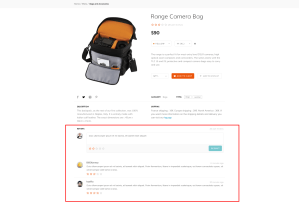
Source – Milano
5. Exchange & Return Information:
Building buyer confidence, clear exchange and return information should be easily discoverable. Placing this information in prominent locations, such as the header, footer, FAQ section, and product catalog pages, ensures customers are aware of the brand’s flexibility.
6. FAQs Section:
A well-curated FAQs section eliminates the need for customers to search elsewhere for information. Addressing potential queries related to products and leveraging insights from support representatives can enhance customer understanding and satisfaction.

Source – Fashion Nova
7. Order Tracking:
Providing customers with real-time updates on their orders from confirmation to delivery enhances transparency and customer satisfaction. Order tracking not only keeps customers informed but also serves as an opportunity for additional upselling.
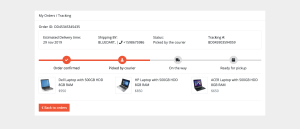
Source – Bootstrap
8. Web Push Notifications:
Web push notifications are a dynamic tool for creating awareness around new offers, product launches, and order updates. Easy to integrate, they open avenues for increased customer interaction and engagement opportunities.

Source- Subscriber Interests
9. Chatbots:
AI-powered chatbots offer a round-the-clock presence to assist customers with queries. Benefits include efficient customer support, immediate query resolution, and the potential to enhance client relations through personalized assistance.
10. Sort and Filter Options:
Enhance the buying process by offering diverse sorting and filtering options. Popular choices include price, relevance, popularity, and product specifications, simplifying the customer journey and minimizing search efforts.

Source – Wix
11. Multiple Payment Options:
Diversify payment options to cater to various customer preferences. Avoid losing sales due to technical issues or forgotten credentials by providing multiple payment methods, ensuring a seamless checkout experience for every customer.
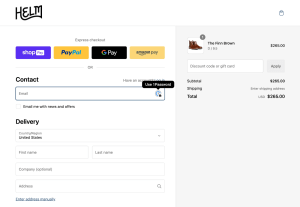
Source – Helm
Major Factors Affecting The eCommerce Website Development Cost in 2024
Getting to grips with eCommerce website development costs requires a proper understanding of various factors that can influence the budget. From project complexity to technology stack choices, each element plays a role in determining the overall cost. In this section, we’ll dive into the key factors that can sway eCommerce development costs, highlighting areas that businesses should consider when embarking on this crucial journey.
1. Website Type:
Choosing between a template-based and custom website design significantly impacts development costs. While templates offer a quick start, custom websites provide unparalleled flexibility and uniqueness. In 2024, leaning towards custom solutions is advisable, considering the ever-growing demand for tailored user experiences and brand individuality. Custom websites align more seamlessly with specific business requirements, offering a competitive edge in the dynamic eCommerce landscape.
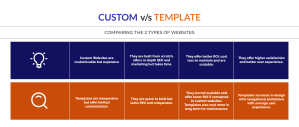
2. Platform and Technology:
The selection of website development platforms plays a pivotal role. Popular platforms like Shopify, WooCommerce, and Magento each have their strengths and considerations. In 2024, it’s essential to choose a platform aligned with business needs and one that your in-house development team is comfortable working with. Opting for familiar technology ensures efficiency, faster development, and streamlined maintenance.
When choosing a shopify development agency, be sure to check the company’s past clients, feedback and relevant experience in the eCommerce domain before handing over your project requirements.
3. Website Design:
From a branding perspective, custom website designs empower businesses to exert precise control over their online presence, driving brand identity and enhancing user experience. In 2024, the shift towards custom designs is accentuated, emphasizing the pivotal role design plays in conversion. Custom designs offer the flexibility needed to create visually appealing, brand-aligned interfaces that resonate with and convert visitors into customers.
4. Components & Complexity:
The complexity of website components directly influences development costs. Integrating advanced features such as personalized user experiences, sophisticated navigation, or AI-driven functionalities requires more resources and, consequently, impacts the budget. In 2024, businesses must carefully assess their requirements and strike a balance between innovative features and development costs to ensure optimal functionality without unnecessary expenses. Consider partnering with an MVP development services to assist with the first roll out of your eCommerce website.
5. Content Generation:
The way content is generated can significantly impact costs. Choosing between cookie-cutter content and branded copywriting depends on the business goals. In 2024, the trend leans towards branded copywriting that not only serves its informational purpose but also strategically converts visitors into customers. Investing in compelling, brand-aligned content enhances the overall user experience and contributes to conversion optimization.
6. Hosting and Domain:
The hosting service provider, hosting packages, and domain registration directly contribute to website development costs. In 2024, businesses should carefully evaluate their hosting needs and select a provider that aligns with their performance and scalability requirements. Efficient hosting ensures a smooth online experience, but it’s crucial to strike a balance between performance and cost-effectiveness.
7. Business System Integration:
Robust backend systems, especially in terms of business system integration, play a vital role in shaping website development costs. In 2024, as eCommerce ecosystems become more intricate, integrating systems like payment gateways with sales and accounting systems demands careful consideration. Businesses should invest in a flexible backend architecture capable of accommodating various integrations to ensure seamless operations and an enhanced user experience.
Tech-Stack Required To Build An eCommerce Website
A tech stack is the combination of programming languages, frameworks, libraries, databases, servers, and other tools that developers use to build and maintain a website or application. In the realm of eCommerce, selecting the right tech stack is crucial for delivering a seamless, secure, and efficient online shopping experience. Let’s take a look at the key components of an eCommerce tech stack and the main factors to consider when making these critical choices.
-
eCommerce Front-end Technologies:
The front-end of an eCommerce website is what users interact with directly. It involves designing and implementing the user interface and user experience. Common technologies include HTML, CSS, and JavaScript. Preprocessors like SASS, PUG, and HAML are also used to streamline and enhance the development process, ensuring a visually appealing and responsive front-end.
-
eCommerce Backend Technologies:
The backend of an eCommerce site handles the server-side operations, database management, and overall functionality. Essential components include databases (e.g., MySQL, PostgreSQL), frameworks (e.g., Django, Ruby on Rails), servers (e.g., Apache, Nginx), and programming languages (e.g., Python, Ruby, PHP). A robust backend ensures secure transactions, efficient data management, and seamless website functionality.
-
Third-Party Services:
eCommerce websites often integrate third-party services to enhance functionality and streamline operations. Analytics tools (e.g., Google Analytics), Customer Relationship Management (CRM) systems, payment gateways (e.g., Stripe, PayPal), shipping modules, and social channel integrations contribute to a comprehensive and feature-rich eCommerce experience.
Key Factors to Consider When Choosing the Technology Stack:
1. Types and Size of Project:
The nature and scale of the project heavily influence the choice of technology stack. Small-scale projects may benefit from lightweight frameworks, while larger enterprises might require more robust solutions. Consider the project’s complexity, expected traffic, and features to align the tech stack with its specific requirements.
2. Budget:
Budget constraints play a significant role in determining the technology stack. Open-source technologies may be cost-effective, while proprietary solutions might offer advanced features but at a higher cost. Balancing cost considerations with the desired functionality is crucial for a sustainable and effective tech stack.
3. Compatibility:
Ensuring compatibility between existing platforms and new tools is essential for a seamless integration process. Evaluate how well the chosen tech stack aligns with the existing infrastructure, databases, and technologies to minimize potential conflicts and streamline development.
4. Time to Market:
The urgency to bring a product to market influences the technology stack selection. Some frameworks and platforms offer rapid development capabilities, accelerating the time to market. Balancing speed with long-term scalability is crucial to meet business timelines without compromising future growth.
5. Scalability:
Scalability is a critical consideration for growing eCommerce businesses. The chosen tech stack should be capable of accommodating increased traffic, expanding product catalogs, and evolving features without compromising performance. Ensure that the stack aligns with the scalability requirements of the business as it grows.
Making informed decisions based on these factors ensures that the technology stack is tailored to the unique needs of the eCommerce project, setting the foundation for a successful and sustainable online presence.
eCommerce Website Development Cost Breakdown
We’ve looked at all the possible areas concerning the cost of eCommerce website development. Time now to see service-by-service cost to build an ecommerce website. We’ve shared the cost estimates for both custom eCommerce development and using a turnkey eCommerce software below:
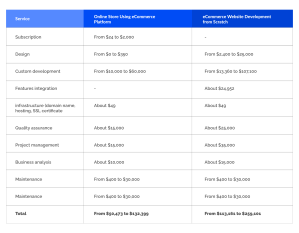
Why Choose InfoStride For Your Next eCommerce Website Development Project
The eCommerce market presents an unprecedented opportunity for businesses to thrive and profit. With the ever-growing digital landscape and evolving consumer preferences, the potential for success is immense. To harness this potential, it’s crucial for aspiring entrepreneurs to seek the expertise of eCommerce website development companies. That’s where we come in.
Whether you’re starting your eCommerce business idea from scratch, expanding your team, or enhancing existing platforms, InfoStride has the capacity to transform ideas into successful projects.
InfoStride is a full-service eCommerce development company. Trusted as Shopify and Magento development agency, we bring years of expertise in crafting tailored solutions for your business. Reach out to our experts today to discuss your ecommerce website idea.

